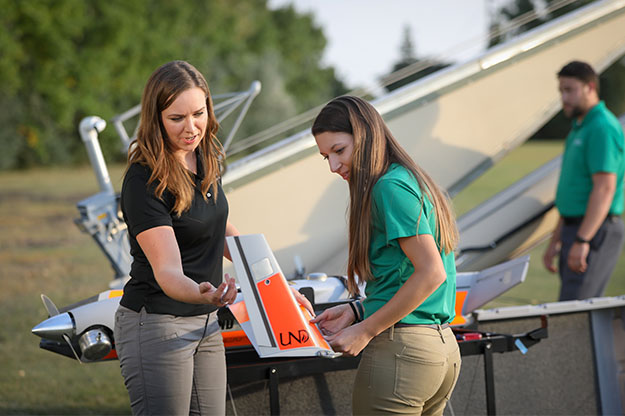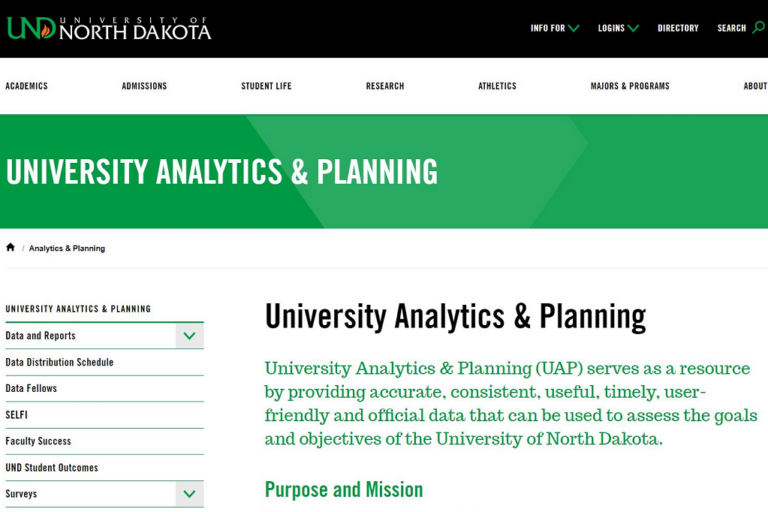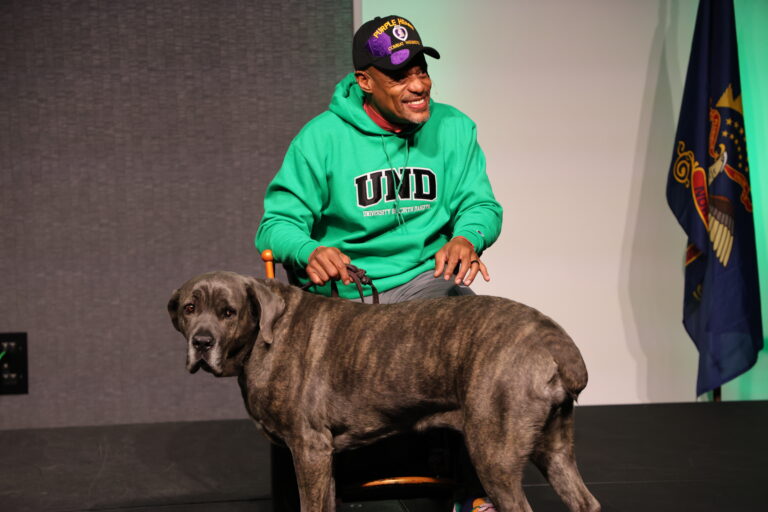Growing research, fostering inclusion
Latest Provost Forum reveals progress in UND Strategic Plan’s discovery and engagement goals

Grant McGimpsey wears many hats at the University of North Dakota. He’s the vice president for Research & Economic Development, the dean of the School of Graduate Studies, and the captain of the One UND Strategic Plan’s Goal No. 4.
At the public Provost Forum on Nov. 30, he added another hat to the stack.
“Provost [Tom] DiLorenzo isn’t here today, so I’m channeling him,” he joked to the faculty, staff and administrators in the Education Building lecture bowl.
McGimpsey was joined by Goal No. 5 captain and Vice President for Student Affairs & Diversity Cara Halgren, as they led the audience through the progress of their goals – enhancing research and fostering a welcoming, safe and inclusive campus climate, respectively.

Enhancing discovery
The aim of Goal No. 4 is lifting discovery to a level consistent with most research intensive universities – those with a Carnegie R1 rating. The metric McGimpsey’s team is using to measure its progress is research expenditures, with a target of $120 million in internal and external funding by 2022.

“We’re currently at about $93 million in total expenditures,” McGimpsey said, “so we’re three-quarters of the way there. The rest of this particular goal focuses on how we get the rest of the way.”
UND will get there by following seven action steps. The implementation team has already designated champions to lead its five Grand Challenge areas, many of which have executed successful seed funding programs to help researchers promote collaboration and gain additional external funding in the areas of energy, health, UAS and data.
The team is also investigating a better way to accurately capture faculty time devoted to research through Page 2 reports, work supported by Frank Swiontek and his Institutional Effectiveness data team. McGimpsey said this will help boost the reported research expenditures necessary for a higher Carnegie rating.
The third action item is an examination of how to best recruit and keep star researchers. McGimpsey expanded on the importance of the fourth action item – increasing post-doctoral researchers – explaining how faculty fellow John Mihelich is streamlining the post-doc hiring process.
“We have a vibrant graduate research enterprise. The next step to becoming Carnegie R1, as a part of that evaluation, is to create a vibrant post-doctoral research enterprise,” he said.
Just as important are the final three action steps – identifying high-potential research based Ph.D. programs, creating department and college level expectations and evaluations for research, scholarship and creative activities (a project spearheaded by faculty fellow David Flynn, who is examining a more responsive and simplified Digital Measures platform), and investing in high-performance computing, cyber security and data analytics capabilities and infrastructure.
“The amount of data that the human race has created in the last two years is more than what was created in the entire history of the human race before that,” McGimpsey said. “We need to have computational capabilities that allow us to store that data, analyze that data, and make something out of it that’s useful.”
Diversity & inclusion
Halgren transitioned from data to diversity, noting that there’s no perfect blueprint for creating a flawless campus environment.
“We’ve generated a lot of good discussion,” she said. “I acknowledge that this is not the ‘be-all, end-all’ plan, but we hope that this is a great start.”
One of the committee’s biggest tasks has been planning how to best reorganize the Diversity & Inclusion Department to better serve students. They are currently in conversations with the Community Violence Intervention Center (CVIC) to create a memorandum of understanding to form CVIC@UND – a space at UND that would provide information on healthy relationships, bystander intervention and more, building on the offerings of the former Women’s Center. Halgren hopes to have a partnership worked out by January.
Halgren’s team has made four recent visits to state tribal institutions to speak with college leaders, asking what UND can do better to build stronger connections.

“They provided a lot of solid feedback,” she said. “They want us to think more clearly about articulation agreements – what is currently in place, and what needs to happen to ensure that a student graduating from a tribal institution can come to UND and experience success without barriers.”
The group is also excited about the progress of an action step that calls for increasing opportunities for cross-cultural interaction and engagement.
“Incredible things happen on this campus,” Halgren said, pointing to examples like the Feast of Nations, Wacipi & Time Out Week and the UND Writers Conference. “We’re looking at how we ensure that the freshmen class coming in next fall, when they start here at orientation, have a clear idea of the great programs happening during the course of their first year.”
By June 1, Halgren expects to roll out a single brochure, compiled by campus programmers, that lays out the academic year’s big events. Her group is also exploring ways to incentivize attendance through opportunities for prizes, scholarship drawings, or discounts for study abroad trips.
Halgren noted that she’s heard many questions about whether a replacement leader for Diversity & Inclusion would be hired, a role that was vacated this summer.
“I want to do this right,” she said, “and I want to take the time to have conversations with people about what this position could look like to ensure that, when we do this, people can be supportive of it and feel that it truly represents the best interests for students and the University.”
The year’s final forum will be held Dec. 13 in Education Building Room 7 from 3:30-4:30 p.m., and will address Goal No. 7, MIRA, and budget questions.


